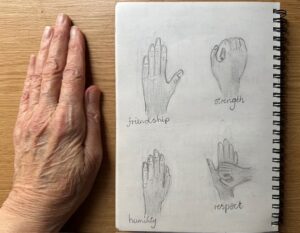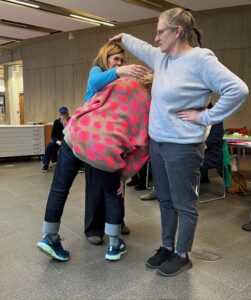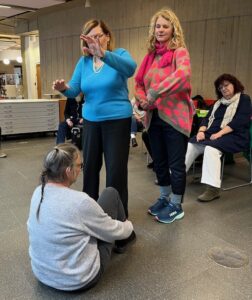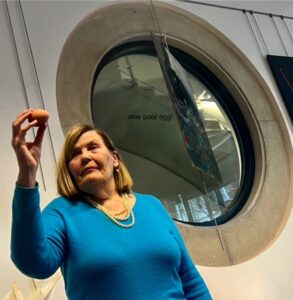Slowly, slowly our Group is edging towards the performance of Rafal’s March production. It has taken me four sessions to realise that his inspiration feeds off our responses to the improv sessions as much as we feed off the sessions. Working together generates and releases the most amazing creativity. And improv is improved one hundred per cent when the participants are relaxed.
On Monday Kirsty began by asking us for a brief “weather report” on how we were each feeling. This gave us a chance to share our Monday morning moods and to begin to wind down. Then she took us through a series of breathing exercises based on seated Tai Chi. Apparently deep breathing and sighing stimulates the Vagus Nerve.
Vagus Nerve
longest cranial nerve in the body
It extends from the brain to various organs and the abdomen
It’s paired with left and right sides of the brain
The vagus nerve plays a role in swallowing/ coughing /breathing/ heart rate and digestion
It’s an important part of the parasympathetic nervous system – rest and digest
Stimulation of the vagus nerve helps to trigger your body’s calming system
(See Deb Dane on YouTube for more information)
Ahhhhhhh! Now we were relaxed and ready for movement.
First Kirsty showed us four hand gestures but I was so busy trying to make a note of what they were they I completely missed the point. Why? I shall ask Kristy at the next session. . .

Sitting on our chairs in a circle Kirsty guided us to work in threes then in a larger group adopting poses based on the theme of taking up our own pose to copy/ contrast or complement the pose of the previous participant.
Next we had to work on our own, “making friends with the concrete wall” and working intimately with the wall. Leaning on the wall, sliding up and down the wall, feeling the texture of the concrete surface, pushing away from the wall – moving slowly all the time to the music of “spiegel im spiegel”. I found it easiest to do this with my eyes shut, so that I could really focus on the wall without distraction.
Kirsty asked for our response to the activity. “losing myself in the music. . .” “ being at one with the wall. . .” “curious and connected. . .” “something powerful between me and the wall. . .” “closing eyes, being in the moment. . .”
Now was the time to work with an egg. Kirsty wanted us to work in threes to create a space dedicated to our egg then to move around the egg totally focused on the egg. Group One chose to place their egg on a trolley then perform movements around and with this trolley, sometimes pullling, sometimes pushing, both opposing and working with each other. Group Two made a dramatic entrance from a door to ‘worship’ their egg which was tucked behind a pillar. My Group used a chair and masking tape to create a tree then performed in front of it. G. was the tree on whose ‘branches’ the egg rested, and B. was the bird who flies in to steal the egg. Because I was trying to video our piece my bit of movement was tacked on at the end, when B. passed the egg to me and I held it aloft to gaze at it admiringly. “Alas poor egg . . .” (To parody Shakespeare”)
So: that was “the body in space”. Next time we look at “scores”. In performance art, a score is a written notation of a musical or dance composition, which allows the work to be performed at a later date or by another performer. Are we up for the challenge? Of course, each session leads us closer to our goal and, anyway, it is fun. “Playing” for grown-ups, as it were.
 Follow
Follow
Leave a Reply